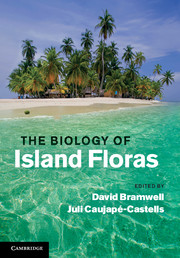Book contents
- Frontmatter
- Contents
- Contributors
- Preface
- 1 Introduction: islands and plants
- 2 The reproductive biology of island plants
- 3 Spatial methodologies in historical biogeography of islands
- 4 Origin and evolution of Hawaiian endemics: new patterns revealed by molecular phylogenetic studies
- 5 Origins and evolution of Galapagos endemic vascular plants
- 6 The plants of the Caribbean islands: a review of the biogeography, diversity and conservation of a storm-battered biodiversity hotspot
- 7 The biogeography of Madagascar palms
- 8 Evolution and biogeography of the flora of the Socotra archipelago (Yemen)
- 9 Biogeography and conservation of the flora of New Caledonia
- 10 Phytogeography and relationships of the Pitcairn Islands flora
- 11 Chromosomes and evolution in New Zealand endemic angiosperms and gymnosperms
- 12 Jesters, red queens, boomerangs and surfers: a molecular outlook on the diversity of the Canarian endemic flora
- 13 Endemism and evolution in Macaronesian and Mediterranean Limonium taxa
- 14 Dispersal, diversity and evolution of the Macaronesian cryptogamic floras
- 15 Invasive alien species and islands
- 16 Ecology, demography and conservation in the Galapagos Islands flora
- 17 New directions and challenges for the conservation of the flora of Madagascar
- 18 Climate change and island floras
- 19 Conservation status of endemic plants on Isla del Coco, Costa Rica: applying IUCN Red List criteria on a small island
- 20 Botanic gardens and the conservation of island floras
- 21 The hazardous future of island floras
- Index
- References
14 - Dispersal, diversity and evolution of the Macaronesian cryptogamic floras
Published online by Cambridge University Press: 07 October 2011
- Frontmatter
- Contents
- Contributors
- Preface
- 1 Introduction: islands and plants
- 2 The reproductive biology of island plants
- 3 Spatial methodologies in historical biogeography of islands
- 4 Origin and evolution of Hawaiian endemics: new patterns revealed by molecular phylogenetic studies
- 5 Origins and evolution of Galapagos endemic vascular plants
- 6 The plants of the Caribbean islands: a review of the biogeography, diversity and conservation of a storm-battered biodiversity hotspot
- 7 The biogeography of Madagascar palms
- 8 Evolution and biogeography of the flora of the Socotra archipelago (Yemen)
- 9 Biogeography and conservation of the flora of New Caledonia
- 10 Phytogeography and relationships of the Pitcairn Islands flora
- 11 Chromosomes and evolution in New Zealand endemic angiosperms and gymnosperms
- 12 Jesters, red queens, boomerangs and surfers: a molecular outlook on the diversity of the Canarian endemic flora
- 13 Endemism and evolution in Macaronesian and Mediterranean Limonium taxa
- 14 Dispersal, diversity and evolution of the Macaronesian cryptogamic floras
- 15 Invasive alien species and islands
- 16 Ecology, demography and conservation in the Galapagos Islands flora
- 17 New directions and challenges for the conservation of the flora of Madagascar
- 18 Climate change and island floras
- 19 Conservation status of endemic plants on Isla del Coco, Costa Rica: applying IUCN Red List criteria on a small island
- 20 Botanic gardens and the conservation of island floras
- 21 The hazardous future of island floras
- Index
- References
Summary
The Macaronesian region comprises the volcanic, oceanic archipelagos of the Cape Verdes, the Canaries, the Savage or Selvagem Islands, Madeira and the Azores, located in the Atlantic Ocean between 15 and 30°N (Fig. 14.1). In keeping with other volcanic oceanic archipelagos, Macaronesia is characterised by high levels of endemicity and recent years have seen the rapid development of novel hypotheses to explain aspects of the evolution of diversity in the region. The availability of checklists for the biota for each of the Macaronesian archipelagos (Izquierdo et al., 2004; Arechavaleta et al., 2005; Borges et al., 2005a, 2008) has led to the development of new hypotheses to explain diversity patterns in the flora in relation to abiotic factors (Emerson & Kolm, 2005; Whittaker et al., 2007, 2008; Borges & Hortal, 2009). Silvertown (2004; see also Silvertown et al., 2005; and for other views, Herben et al., 2005; Saunders & Gibson, 2005) reviewed the results of phylogenetic analyses and suggested that ‘niche pre-emption’ may explain the radiation of some groups but not others. Carine et al. (2010) also used phylogenetic data to demonstrate that angiosperm groups which showed island woodiness (i.e. the evolution of woodiness linked to the colonisation of islands) were typically more species-rich than groups with the same habit on both continent and islands and hypothesised that the evolution of woodiness promoted diversification. Data from checklists together with phylogenetic information led Carine and Schaefer (2010) to suggest that differences in the climatic histories of the Canaries and Azores may explain the marked differences observed in patterns of endemicity in the angiosperm floras of the two archipelagos.
- Type
- Chapter
- Information
- The Biology of Island Floras , pp. 338 - 364Publisher: Cambridge University PressPrint publication year: 2011
References
- 24
- Cited by



